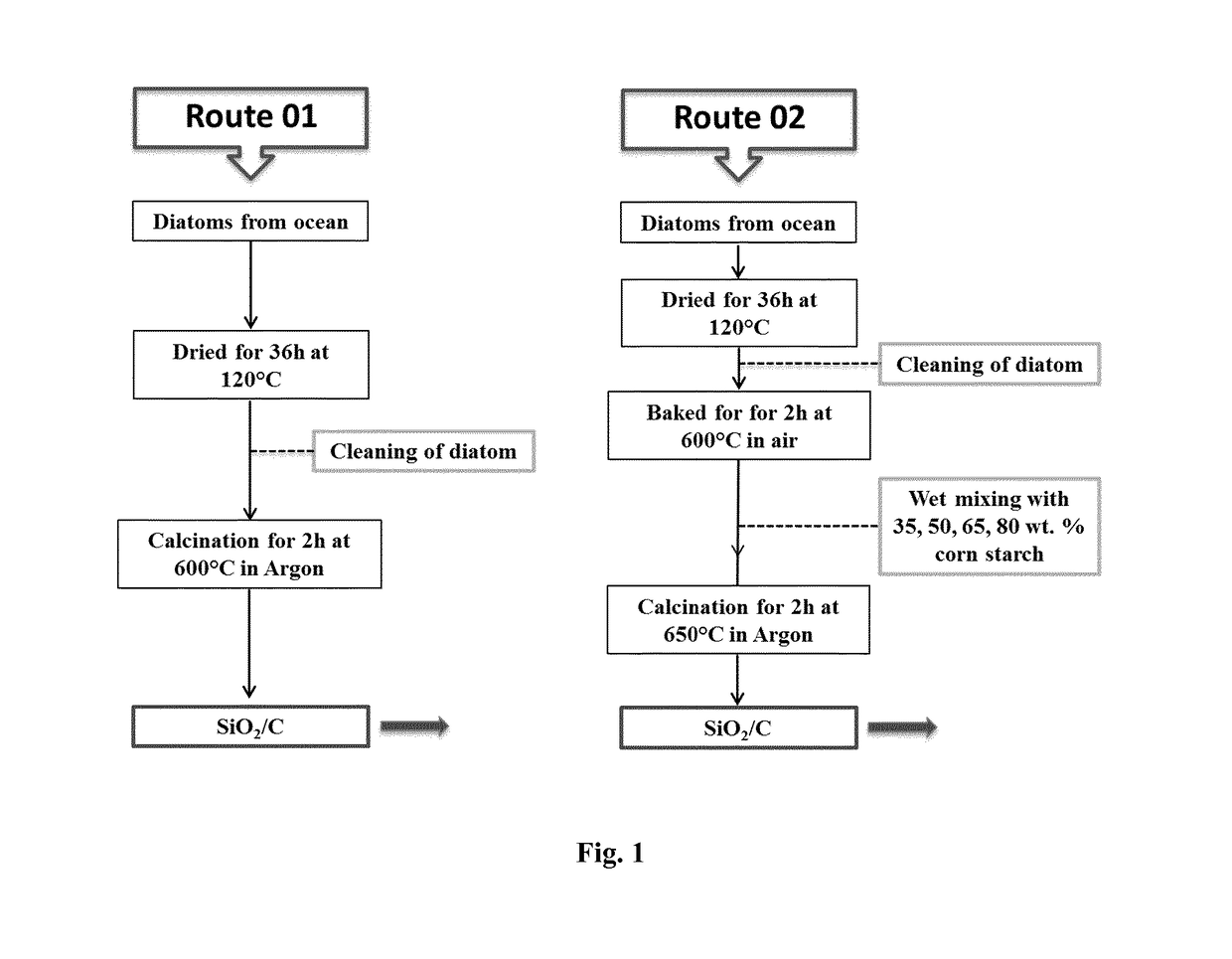Anode containing diatom frustules
a technology of diatom frustules and anodes, which is applied in the direction of silicon oxides, cell components, electrochemical generators, etc., can solve the problems of incomplete disintegration, poor cyclability, loss of electronic contact with current collectors, etc., and achieve excellent properties and maximise the performance of the binder
- Summary
- Abstract
- Description
- Claims
- Application Information
AI Technical Summary
Benefits of technology
Problems solved by technology
Method used
Image
Examples
example 1
Preparation of SiO2—C Composites—a Porous Silicon Dioxide Network with Carbon Coating
[0125]Two different routes were used to prepare diatom-based anodes (see FIG. 1). Route 1 was followed to prepare carbon coated SiO2 composites where organics present in diatoms were utilized to coat the diatoms. Route 2 was followed using a starch as source of carbon which becomes coated on the diatoms during the process. Preparation procedures of both routes are explained below in details.
[0126]Route1: Diatoms, a major group of algae which grows a cell wall of silica (SiO2) called a frustule, were harvested from northern Norwegian Sea by Planktonik As. These frustules (mainly SiO2) provide a natural nanostructured porous material. The as received diatoms were dried for 36 h at 120° C. Afterwards the dried diatoms were cleaned (procedure provided below) to remove different types of salts present. The diatoms were then calcined at 600° C. for 2 h in argon atmosphere. The organics present in the diat...
example 2
[0127]Route2: Another batch of composites were prepared by using route two where the cleaned diatom samples were baked at elevated temperature (600° C.) for 2 hours in synthetic air. In this step all organics present with the diatom decomposed and left behind SiO2-based porous structure. This nano-structured porous diatom (mainly SiO2) was then mixed with 35-80 wt. % corn-starch as a source of carbon and heat-treated for 2 h at 650° C. in argon filled inert atmosphere. The samples processed following this route are nano-structured porous SiO2 coated with carbon where the coating thickness and amount depends on the amount of corn-starch mixed as a source of carbon. Both calcination and baking were carried out using a horizontal tube furnace (Carbolite Ltd., Sheffield, UK). The processed carbon coated SiO2 composites are denoted as SiO2—C (Stxx). The percentage of starch mixed with SiO2—C composite is filled in xx place of Stxx (e.g. 50 wt. % starch added composite will be denoted as ...
example 3
Diatom Cleaning Procedure
[0128]The dried diatoms were rinsed and put into a large volume of deionized water at room temperature keeping the weight ratio between diatoms and water of 1:70 to 1:100. The temperature of the water increased up to 90° C. under stirring at 400-500 rpm for 2 h. The temperature of the water was reduced to 80° C. for 4 h while keeping the stirring at the same stirring speed. A sieve of mesh size between 32 to 63 μm was used to drain the hot water. Fresh deionized water was added to the sample keeping the weight ratio 1:50 and sonicated for 0.5 h. The diatoms were then washed under flowing water for 5-10 minutes. The process was then repeated. After washing, the samples were dried at 90° C. for 24 h in a drying oven. After removal of the water, the samples were vacuum dried at 150° C. for 18 h. These cleaned diatoms are used for further processing to prepare nano-structured SiO2-based anodes.
PUM
| Property | Measurement | Unit |
|---|---|---|
| wt % | aaaaa | aaaaa |
| temperature | aaaaa | aaaaa |
| voltage | aaaaa | aaaaa |
Abstract
Description
Claims
Application Information
 Login to View More
Login to View More - R&D
- Intellectual Property
- Life Sciences
- Materials
- Tech Scout
- Unparalleled Data Quality
- Higher Quality Content
- 60% Fewer Hallucinations
Browse by: Latest US Patents, China's latest patents, Technical Efficacy Thesaurus, Application Domain, Technology Topic, Popular Technical Reports.
© 2025 PatSnap. All rights reserved.Legal|Privacy policy|Modern Slavery Act Transparency Statement|Sitemap|About US| Contact US: help@patsnap.com



